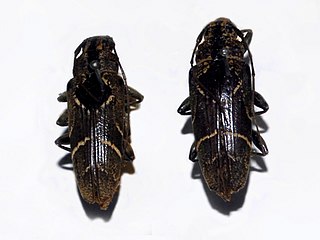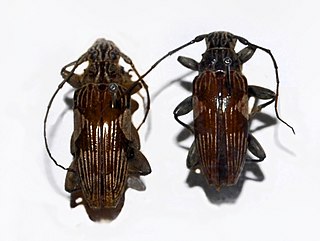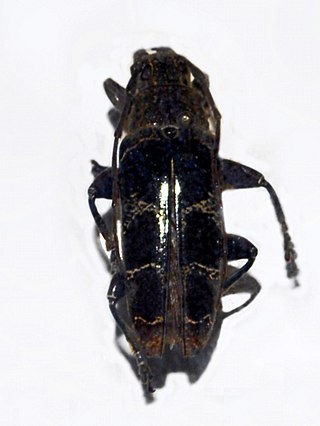
The longhorn beetles (Cerambycidae), also known as long-horned or longicorns, are a large family of beetles, with over 35,000 species described. Most species are characterized by extremely long antennae, which are often as long as or longer than the beetle's body. In various members of the family, however, the antennae are quite short and such species can be difficult to distinguish from related beetle families such as the Chrysomelidae. The scientific name of this beetle family goes back to a figure from Greek mythology: after an argument with nymphs, the shepherd Cerambus was transformed into a large beetle with horns.

An ecosystem engineer is any species that creates, significantly modifies, maintains or destroys a habitat. These organisms can have a large impact on species richness and landscape-level heterogeneity of an area. As a result, ecosystem engineers are important for maintaining the health and stability of the environment they are living in. Since all organisms impact the environment they live in one way or another, it has been proposed that the term "ecosystem engineers" be used only for keystone species whose behavior very strongly affects other organisms.

The black-spotted cuscus is a species of marsupial in the family Phalangeridae. It is among the largest members of the family, only being surpassed by the bear cuscus. It is a relatively colourful species found in forests of northern New Guinea. It is threatened by hunting and habitat loss, and has already disappeared from large parts of its range. Consequently, it is rated as Critically Endangered by IUCN.
Bulinus mutandensis is a species of freshwater gastropod in the Planorbidae family. It is endemic to Uganda. Its natural habitat is freshwater lakes.

The Coral Triangle (CT) is a roughly triangular area in the tropical waters around the Philippines, Indonesia, Malaysia, Papua New Guinea, the Solomon Islands and Timor-Leste. This area contains at least 500 species of reef-building corals in each ecoregion. The Coral Triangle is located between the Pacific and Indian oceans and encompasses portions of two biogeographic regions: the Indonesian-Philippines Region, and the Far Southwestern Pacific Region. As one of eight major coral reef zones in the world, the Coral Triangle is recognized as a global centre of marine biodiversity and a global priority for conservation. Its biological resources make it a global hotspot of marine biodiversity. Known as the "Amazon of the seas" (by analogy to the Amazon rainforest in South America), it covers 5.7 million square kilometres (2,200,000 sq mi) of ocean waters. It contains more than 76% of the world's shallow-water reef-building coral species, 37% of its reef fish species, 50% of its razor clam species, six out of seven of the world's sea turtle species, and the world's largest mangrove forest. In 2014, the Asian Development Bank (ADB) reported that the gross domestic product of the marine ecosystem in the Coral Triangle is roughly $1.2 trillion per year and provides food to over 120 million people. According to the Coral Triangle Knowledge Network, the region annually brings in about $3 billion in foreign exchange income from fisheries exports, and another $3 billion from coastal tourism revenues.
Neomallodon is a genus of beetles in the family Cerambycidae. It is monotypic, being represented by the single species Neomallodon arizonicus.
Rhopalophora prolixa is a species of beetle belonging to the family Cerambycidae. First described by Monné in 1989, this beetle is part of the vast and diverse world of longhorn beetles.

Tmesisternus adspersus is a species of longhorn beetles belonging to the family Cerambycidae, subfamily Lamiinae.

Tmesisternus sulcatus is a species of longhorn beetles belonging to the family Cerambycidae, subfamily Lamiinae.

Tmesisternus politus is a species of longhorn beetles belonging to the family Cerambycidae, subfamily Lamiinae.

Tmesisternus arfakianus is a species of beetle in the family Cerambycidae. It was described by Gestro in 1876. It is known from Papua New Guinea.
Tmesisternus attenuatus is a species of beetle in the family Cerambycidae. It was described by Gressitt in 1984. It is known from Papua New Guinea.
Tmesisternus excellens is a species of beetle in the family Cerambycidae. It was described by Per Olof Christopher Aurivillius. It is known from Papua New Guinea.
Tmesisternus fuscosignatus is a species of beetle in the family Cerambycidae. It was described by Stephan von Breuning 1945. It is known from Papua New Guinea.
Tmesisternus gabrieli is a species of beetle in the family Cerambycidae. It was described by Bernhard Schwarzer in 1931. It is known from Papua New Guinea.
Tmesisternus heurni is a species of beetle in the family Cerambycidae. It was described by Bernhard Schwarzer in 1924. It is known from Papua New Guinea.
Tmesisternus postfasciatus is a species of beetle in the family Cerambycidae. It was described by Stephan von Breuning and De Jong in 1941. It is known from Papua New Guinea.
Tmesisternus sedlaceki is a species of beetle in the family Cerambycidae. It was described by Gressitt in 1984. It is known from Papua New Guinea.
Tmesisternus toxopei is a species of beetle in the family Cerambycidae. It was described by Gressitt in 1984. It is known from Papua New Guinea.
Rhynchus is a genus of hidden snout weevils in the family of beetles known as Curculionidae. There is at least one described species in Rhynchus, R. apiculatus.







